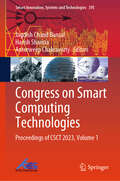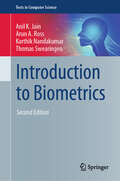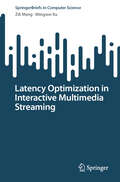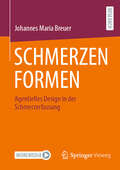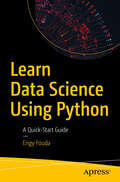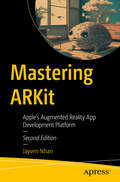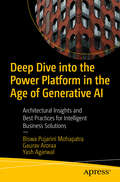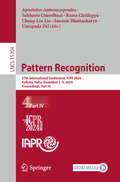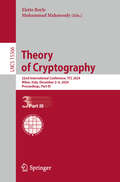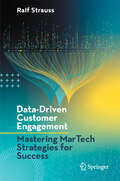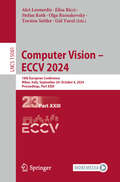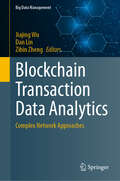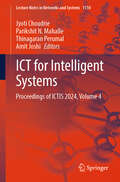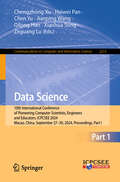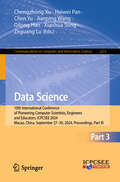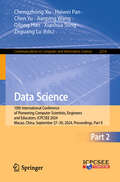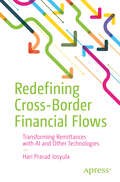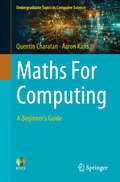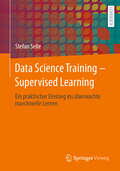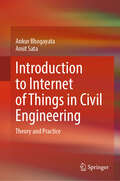- Table View
- List View
Congress on Smart Computing Technologies: Proceedings of CSCT 2023, Volume 1 (Smart Innovation, Systems and Technologies #395)
by Jagdish Chand Bansal Harish Sharma Antorweep ChakravortyThis book presents high-quality research papers presented at Congress on Smart Computing Technologies (CSCT 2023) organized by SAU Center for Research and Innovative Learning (SCRIL), South Asian University, India, from 2–3 December 2023. The book extensively covers recent research in algorithms for smart computing, AI and machine learning in smart computing, edge computing algorithms, adversarial networks and autoencoders, data visualization, data mining, data analytics, machine learning, game theory, high-performance computing, mobile and ubiquitous platforms for smart environments, cloud/edge/fog computing technologies for smart systems, Internet of Things (IoT) and industrial IoT technologies for smart systems, smart device and hardware, security, privacy, and economics in smart environments, big data, healthcare informatics, smart precision agriculture, smart transportation, social network analysis, and human–computer interaction. The work is presented in two volumes.
Introduction to Biometrics (Texts in Computer Science)
by Anil K. Jain Arun A. Ross Karthik Nandakumar Thomas SwearingenThis textbook introduces the fundamental concepts and techniques used in biometric recognition to students, practitioners, and non-experts in the field. Specifically, the book describes key methodologies used for sensing, feature extraction, and matching of commonly used biometric modalities such as fingerprint, face, iris, and voice. In addition, it presents techniques for fusion of biometric information to meet stringent accuracy requirements, also discussing various security issues and associated remedies involved in the deployment of biometric systems. Furthermore, this second edition captures the progress made in the field of biometric recognition, with highlights including: Lucid explanation of core biometric concepts (e.g., individuality and persistence), which builds a strong foundation for more in-depth study and research on biometrics A new chapter on deep neural networks that provides a primer to recent advancements in machine learning and computer vision Illustrative examples of how deep neural network models have contributed to the rapid evolution of biometrics in areas such as robust feature representation and synthetic biometric data generation A new chapter on speaker recognition, which introduces the readers to person recognition based on the human voice characteristics Presentation of emerging security threats such as deepfakes and adversarial attacks and sophisticated countermeasures such as presentation attack detection and template security While this textbook has been designed for senior undergraduate students and first-year graduate students studying a course on biometrics, it is also a useful reference guide for biometric system designers, developers, and integrators.
Latency Optimization in Interactive Multimedia Streaming (SpringerBriefs in Computer Science)
by Mingwei Xu Zili MengWith the emergence of virtual reality and augmented reality, the era of interactive multimedia streaming looms on the horizon. Network latency emerges as a critical factor in the performance of interactive multimedia streaming applications. As the demand for interactive multimedia streaming continues to surge, comprehending and mitigating the challenges posed by network latency becomes increasingly imperative. This book begins by introducing the fundamentals of network latency, elucidating its sources from both data plane and control plane, along with its effects on user experience. Furthermore, it explores the various components contributing latency, including the application layer, transport layer, and network layer. The book then delves into the ongoing research efforts aimed at reducing the latency of these components individually. By the book's conclusion, readers will have gained a comprehensive understanding of network latency in interactive multimedia streaming, equipped with the knowledge and tools necessary to design and optimize low-latency streaming systems. Whether you are a network engineer, multimedia developer, or researcher, this book will furnish you with valuable insights and practical guidance to confront the challenges of network latency head-on.
SCHMERZEN FORMEN: Agentielles Design in der Schmerzerfassung
by Johannes Maria BreuerWie stark sind die Schmerzen auf einer Skala von 1 bis 10? Sind sie pochend, stechend, pulsierend? Adäquate Schmerzerfassung stellt schon immer eine Herausforderung dar. Oftmals sind die Kategorien aktueller Instrumente allzu vereinfachend. Umfassendere, multidimensionale Assessments sind wiederum aufwendig und können für die Patient*innen eine Überforderung darstellen. Daher wird die Entwicklung einer intuitiven visuellen Form der Schmerzerfassung empfohlen. Sie berücksichtigt die Wechselwirkung zwischen Schmerzerleben und Schmerzrepräsentation in der Agentialität des Designs. Das Ergebnis ist ein digitales System, das durch die Modellierung multipler grafischer Parameter Schmerzen fluide, körperbezogen und mehrdimensional erfasst. Das System ermöglicht eine präzisere Verfolgung des Therapieverlaufs, kann die Körperwahrnehmung der Patient*innen verbessern und liefert Daten für eine patientenzentrierte und datengetriebene Medizin.
Learn Data Science Using Python: A Quick-Start Guide
by Engy FoudaHarness the capabilities of Python and gain the expertise need to master data science techniques. This step-by-step book guides you through using Python to achieve tasks related to data cleaning, statistics, and visualization. You’ll start by reviewing the foundational aspects of the data science process. This includes an extensive overview of research points and practical applications, such as the insightful analysis of presidential elections. The journey continues by navigating through installation procedures and providing valuable insights into Python, data types, typecasting, and essential libraries like Pandas and NumPy. You’ll then delve into the captivating world of data visualization. Concepts such as scatter plots, histograms, and bubble charts come alive through detailed discussions and practical code examples, unraveling the complexities of creating compelling visualizations for enhanced data understanding. Statistical analysis, linear models, and advanced data preprocessing techniques are also discussed before moving on to preparing data for analysis, including renaming variables, variable rearrangement, and conditional statements. Finally, you’ll be introduced to regression techniques, demystifying the intricacies of simple and multiple linear regression, as well as logistic regression. What You’ll Learn Understand installation procedures and valuable insights into Python, data types, typecasting Examine the fundamental statistical analysis required in most data science and analytics reports Clean the most common data set problems Use linear progression for data prediction Who This Book Is For Data Analysts, data scientists, Python programmers, and software developers new to data science.
Mastering ARKit: Apple’s Augmented Reality App Development Platform
by Jayven NhanEmbark on a journey to build an augmented reality world. This book puts theory into practical application by building unique augmented reality apps specific to each chapter’s topic. You’ll learn to engineer successful, well-designed, and comprehensive augmented reality applications for iOS devices. This updated edition has been thoroughly revised to cover the latest advancements in iOS 17 and Xcode 15, equipping you with the knowledge and tools to build cutting-edge augmented reality experiences. Starting with the foundation of augmented reality on Apple platforms, you will understand the building blocks and inner workings of the technologies that power augmented reality. Then, delve into the practicalities of building AR apps using ARKit, SceneKit, SpriteKit, RealityKit, and integrating with SwiftUI and advanced features like ReplayKit for recording experiences. Explore augmented reality app business models, designs, and content for the ultimate user experience. This book covers a wide range of ARKit APIs and topics, including surface detection, 3D objects implementation, horizontal plane detection with raycast, physics by launching rocket ships, light estimation, 2D image recognition, world-mapping data for persistence, immersive audio experiences, real-time image analysis, machine learning, face and body motion capture, people occlusion, and more. Chapter by chapter, this book guides you to become an advanced augmented reality engineer for Apple’s platforms. By the end of the book, you’ll have acquired the necessary mental models and tools to engineer delightful experiences in Apple’s augmented reality ecosystem. What You'll Learn Construct AR apps using SceneKit, SpriteKit, RealityKit, and integrate with SwiftUI. Leverage ARKit for advanced features like face and body motion capture, people occlusion, and world tracking. Incorporate 3D objects, surface detection, computer vision, and body motion capture in your apps. Implement persistence in AR experiences and create shared experiences using Multipeer Connectivity. Who This Book Is For iOS developers who want to expand their knowledge of ARKit. Ideal for those with a solid foundation in Swift and familiarity with Xcode, seeking to explore the expansive capabilities of augmented reality on Apple devices.
Deep Dive into the Power Platform in the Age of Generative AI: Architectural Insights and Best Practices for Intelligent Business Solutions
by Gaurav Aroraa Biswa Pujarini Mohapatra Yash AgarwalUnderstand the full potential of Microsoft Power Platform with this comprehensive guide, designed to provide you with the knowledge and tools needed to create intelligent business applications, automate workflows, and drive data-driven insights for business growth. Whether you're a novice or an experienced professional, this book offers a step-by-step approach to mastering the Power Platform. This book comes with an extensive array of essential concepts, architectural patterns and techniques. It will also guide you with practical insights to navigate the Power Platform effortlessly while integrating on Azure. Starting with exploring Power Apps for building enterprise applications, the book delves into Dataverse, Copilot Studio, AI Builder, managing platforms and Application life cycle management. You will then demonstrate testing strategy followed by a detailed examination of Dataverse and intelligent AI-powered Applications. Additionally, you will cover Power pages for external websites and AI-infused solutions. Each section is meticulously structured, offering step-by-step guidance, hands-on exercises, and real-world scenarios to reinforce learning. After reading the book, you will be able to optimize your utilization of the Power Platform for creating effective business solutions. What You Will Learn: Understand the core components and capabilities of Power Platform Explore how Power Platform integrates with Azure services Understand the key features and benefits of using Power Platform for business applications Discover best practices for governance to ensure compliance and efficient management Explore techniques for optimizing the performance of data integration and export processes on Azure Who This Book Is For: Application developers, Enterprise Architects and business decision-makers.
Girlhood, Schools, and Media: Popular Discourses of the Achieving Girl (Routledge Research in Cultural and Media Studies)
by Michele PauleThis book explores the circulation and reception of popular discourses of achieving girlhood, and the ways in which girls themselves participate in such circulation. It examines the figure of the achieving girl within wider discourses of neoliberal self-management and post-feminist possibility, considering the tensions involved in being both successful and successfully feminine and the strategies and negotiations girls undertake to manage these tensions.The work is grounded in an understanding of media, educational, and peer contexts for the production of the successful girl. It traces narratives across school, television and online in texts produced for and by girls, drawing on interviews with girls in schools, online forum participation (within the purpose-built site www.smartgirls.tv), and girls’ discussions of a range of teen dramas.
Recent Trends in Analysis of Images, Social Networks and Texts: 11th International Conference, AIST 2023, Yerevan, Armenia, September 28–30, Revised Selected Papers (Communications in Computer and Information Science #1905)
by Panos M. Pardalos Andrey V. Savchenko Dmitry I. Ignatov Alexander Panchenko Michael Khachay Andrey Kutuzov Elena Tutubalina Ilya Makarov Evgenii Tsymbalov Habet Madoyan Irina Nikishina Maxim Panov Sergey ZagoruykoThis book constitutes the refereed proceedings of the 11th International Conference on Recent Trends in Analysis of Images, Social Networks and Texts, AIST 2023, held in Yerevan, Armenia, during September 28–30, 2023. The 19 full papers 2 short papers and 1 demo paper included in this book were carefully reviewed and selected from 52 submissions. They were organized in topical sections as follows: Natural Language Processing; Computer Vision; Data Analysis and Machine Learning; Network Analysis; Theoretical Machine Learning and Optimization; and Demo Paper.
Pattern Recognition: 27th International Conference, ICPR 2024, Kolkata, India, December 1–5, 2024, Proceedings, Part IV (Lecture Notes in Computer Science #15304)
by Rama Chellappa Subhasis Chaudhuri Cheng-Lin Liu Umapada Pal Apostolos Antonacopoulos Saumik BhattacharyaThe multi-volume set of LNCS books with volume numbers 15301-15333 constitutes the refereed proceedings of the 27th International Conference on Pattern Recognition, ICPR 2024, held in Kolkata, India, during December 1–5, 2024. The 963 papers presented in these proceedings were carefully reviewed and selected from a total of 2106 submissions. They deal with topics such as Pattern Recognition; Artificial Intelligence; Machine Learning; Computer Vision; Robot Vision; Machine Vision; Image Processing; Speech Processing; Signal Processing; Video Processing; Biometrics; Human-Computer Interaction (HCI); Document Analysis; Document Recognition; Biomedical Imaging; Bioinformatics.
Theory of Cryptography: 22nd International Conference, TCC 2024, Milan, Italy, December 2–6, 2024, Proceedings, Part III (Lecture Notes in Computer Science #15366)
by Elette Boyle Mohammad MahmoodyThe four-volume set LNCS 15364-15367 constitutes the refereed proceedings of the 22nd International Conference on Theory of Cryptography, TCC 2024, held in Milan, Italy, in December 2024. The total of 68 full papers presented in the proceedings was carefully reviewed and selected from 172 submissions. They focus on topics such as: proofs; math and foundations; consensus and messaging; quantum; kolmogorov and OWFs; encryption; quantum and black-box separations; authentication and sequentiality; obfuscation and homomorphism; multi-party computation; information-theoretic cryptography; and secret sharing.
Bridging the Gap Between AI and Reality: First International Conference, AISoLA 2023, Crete, Greece, October 23–28, 2023, Selected Papers (Lecture Notes in Computer Science #14129)
by Bernhard SteffenThis open access book constitutes revised selected papers from the First International Conference on Bridging the Gap between AI and Reality, AISoLA 2023, which took place in Crete, Greece, in October 2023. The papers included in this book focus on the following topics: The nature of AI-based systems; ethical, economic and legal implications of AI-systems in practice; ways to make controlled use of AI via the various kinds of formal methods-based validation techniques; dedicated applications scenarios which may allow certain levels of assistance; and education in times of deep learning.
Data-Driven Customer Engagement: Mastering MarTech Strategies for Success
by Ralf StraussEmbark on a journey through the rapidly evolving landscape of Marketing Technology (MarTech) with this comprehensive guide. From understanding the strategic imperatives driving MarTech adoption to navigating the intricacies of data-driven customer interaction, this book provides invaluable insights and practical strategies. Explore topics ranging from budget allocation and market potential to data readiness and GDPR compliance, gaining a deep understanding of key concepts and best practices. Whether you're grappling with the complexities of AI integration or seeking to optimize measurement and KPIs, this book equips you with the knowledge and tools needed to thrive in today's digital marketing environment. With decades of industry experience, Ralf Strauss offers in this book a roadmap for success, empowering marketers to navigate the challenges and seize the opportunities presented by MarTech innovation.
Computer Vision – ECCV 2024: 18th European Conference, Milan, Italy, September 29–October 4, 2024, Proceedings, Part XXIII (Lecture Notes in Computer Science #15081)
by Stefan Roth Aleš Leonardis Elisa Ricci Torsten Sattler Olga Russakovsky Gül VarolThe multi-volume set of LNCS books with volume numbers 15059 up to 15147 constitutes the refereed proceedings of the 18th European Conference on Computer Vision, ECCV 2024, held in Milan, Italy, during September 29–October 4, 2024. The 2387 papers presented in these proceedings were carefully reviewed and selected from a total of 8585 submissions. They deal with topics such as computer vision; machine learning; deep neural networks; reinforcement learning; object recognition; image classification; image processing; object detection; semantic segmentation; human pose estimation; 3d reconstruction; stereo vision; computational photography; neural networks; image coding; image reconstruction; motion estimation.
Blockchain Transaction Data Analytics: Complex Network Approaches (Big Data Management)
by Zibin Zheng Dan Lin Jiajing WuBlockchain, a decentralized ledger technology based on cryptographic algorithms, ensures the creation of immutable and tamper-proof ledgers in decentralized systems. The transparent nature of blockchain allows public access to transaction records, providing unprecedented opportunities for blockchain data analytics and mining. The primary value of blockchain transaction data analytics lies in two aspects: 1) by delving into the details of blockchain transaction data, we can extensively explore various types of user behavior patterns and the evolutionary process of blockchain transaction networks; and 2) analyzing blockchain transaction data aids in identifying illicit activities, offering effective regulatory solutions for the establishment of a healthier blockchain ecosystem. This book focuses on data analytics based on network-based approaches, providing a comprehensive analysis of blockchain data analytics problems, key technologies, and future directions. Different from most existing book, this book takes a unique approach to blockchain data analysis research, focusing on data analytics based on network-based approaches. Leveraging network analysis methods, the book concentrates on three main aspects of blockchain transaction data analytics and mining: (1) transaction network modelling and pattern mining, including macro and micro-level account attributes, money laundering network patterns, and network evolution patterns; (2) account business classification, such as account label prediction based on graph neural networks; and (3) anomaly behavior identification, covering phishing detection, risk scoring, and transaction tracking. Designed as a valuable resource for students, researchers, engineers, and policymakers in various fields related to blockchain data analytics, this book holds significant importance for understanding blockchain transaction behavior and addressing the detection of illicit activities in the blockchain space.
The EU General Data Protection Regulation (GDPR): A Practical Guide
by Paul Voigt Axel von dem BusscheSix years have passed since the General Data Protection Regulation (GDPR) entered into force. With its numerous data protection obligations and the threat of high fines, companies had to change their approach to data protection. It has been an ongoing challenge for companies to keep up with the constant changes deriving from a plethora of new decisions by courts and supervisory authorities. The 2nd Edition of this book provides a practical overview of the requirements of the GDPR. Examples, tables, and checklists showcase the requirements of the GDPR, whilst also giving practical tips to tackle the regulatory challenges. The handbook examines the GDPR’s scope of application, the organisational and material requirements of the GDPR, the rights of data subjects, the role of the supervisory authorities, and enforcement and fines. The book has been completely revised for the second edition and takes extensive account of new data protection case law and regulatory guidelines.
ICT for Intelligent Systems: Proceedings of ICTIS 2024, Volume 4 (Lecture Notes in Networks and Systems #1110)
by Amit Joshi Jyoti Choudrie Parikshit N. Mahalle Thinagaran PerumalThis book gathers papers addressing state-of-the-art research in all areas of information and communication technologies and their applications in intelligent computing, cloud storage, data mining, and software analysis. It presents the outcomes of the 8th International Conference on Information and Communication Technology for Intelligent Systems (ICTIS 2024), held in Ahmedabad, India. The book is divided into six volumes. It discusses the fundamentals of various data analysis techniques and algorithms, making it a valuable resource for researchers and practitioners alike.
Data Science: 10th International Conference of Pioneering Computer Scientists, Engineers and Educators, ICPCSEE 2024, Macao, China, September 27–30, 2024, Proceedings, Part I (Communications in Computer and Information Science #2213)
by Qilong Han Xianhua Song Zeguang Lu Chen Yu Jianping Wang Chengzhong Xu Haiwei PanThis three-volume set CCIS 2213-2215 constitutes the refereed proceedings of the 10th International Conference of Pioneering Computer Scientists, Engineers and Educators, ICPCSEE 2024, held in Macau, China, during September 27–30, 2024. The 74 full papers and 3 short papers presented in these three volumes were carefully reviewed and selected from 249 submissions. The papers are organized in the following topical sections: Part I: Novel methods or tools used in big data and its applications; applications of data science. Part II: Education research, methods and materials for data science and engine; data security and privacy; big data mining and knowledge management. Part III: Infrastructure for data science; social media and recommendation system; multimedia data management and analysis.
Data Science: 10th International Conference of Pioneering Computer Scientists, Engineers and Educators, ICPCSEE 2024, Macao, China, September 27–30, 2024, Proceedings, Part III (Communications in Computer and Information Science #2215)
by Qilong Han Xianhua Song Zeguang Lu Chen Yu Jianping Wang Chengzhong Xu Haiwei PanThis three-volume set CCIS 2213-2215 constitutes the refereed proceedings of the 10th International Conference of Pioneering Computer Scientists, Engineers and Educators, ICPCSEE 2024, held in Macau, China, during September 27–30, 2024. The 74 full papers and 3 short papers presented in these three volumes were carefully reviewed and selected from 249 submissions. The papers are organized in the following topical sections: Part I: Novel methods or tools used in big data and its applications; applications of data science. Part II: Education research, methods and materials for data science and engine; data security and privacy; big data mining and knowledge management. Part III: Infrastructure for data science; social media and recommendation system; multimedia data management and analysis.
Computer Vision – ECCV 2024: 18th European Conference, Milan, Italy, September 29–October 4, 2024, Proceedings, Part XXVIII (Lecture Notes in Computer Science #15086)
by Stefan Roth Aleš Leonardis Elisa Ricci Torsten Sattler Olga Russakovsky Gül VarolThe multi-volume set of LNCS books with volume numbers 15059 up to 15147 constitutes the refereed proceedings of the 18th European Conference on Computer Vision, ECCV 2024, held in Milan, Italy, during September 29–October 4, 2024. The 2387 papers presented in these proceedings were carefully reviewed and selected from a total of 8585 submissions. They deal with topics such as computer vision; machine learning; deep neural networks; reinforcement learning; object recognition; image classification; image processing; object detection; semantic segmentation; human pose estimation; 3d reconstruction; stereo vision; computational photography; neural networks; image coding; image reconstruction; motion estimation.
Data Science: 10th International Conference of Pioneering Computer Scientists, Engineers and Educators, ICPCSEE 2024, Macao, China, September 27–30, 2024, Proceedings, Part II (Communications in Computer and Information Science #2214)
by Qilong Han Xianhua Song Zeguang Lu Chen Yu Jianping Wang Chengzhong Xu Haiwei PanThis three-volume set CCIS 2213-2215 constitutes the refereed proceedings of the 10th International Conference of Pioneering Computer Scientists, Engineers and Educators, ICPCSEE 2024, held in Macau, China, during September 27–30, 2024. The 74 full papers and 3 short papers presented in these three volumes were carefully reviewed and selected from 249 submissions. The papers are organized in the following topical sections: Part I: Novel methods or tools used in big data and its applications; applications of data science. Part II: Education research, methods and materials for data science and engine; data security and privacy; big data mining and knowledge management. Part III: Infrastructure for data science; social media and recommendation system; multimedia data management and analysis.
Redefining Cross-Border Financial Flows: Transforming Remittances with AI and Other Technologies
by Hari Prasad JosyulaAnalyse how AI and other cutting-edge technologies affect the complex web of international financial transactions. The global remittance sector and artificial intelligence (AI) work together in a way that is testament to the revolutionary force of innovation in the always changing financial and technology landscape. As we stand at the threshold of a new age, this book aims to explore the layers of complexity underlying the confluence of AI and remittances. Your investigation will go beyond the current state of affairs and into the future, whereby predictive analytics and autonomous financial transactions will fundamentally alter the way that we send and receive money internationally. This process's incorporation of AI technology represents a revolution rather than a simple progression, one that might improve millions of people's lives by streamlining, securing, and lowering the cost of financial transactions. This book breaks down the complex workings of AI prediction models, reveals how blockchain integration may be used to facilitate safe and transparent transactions, and examines how biometric authentication can strengthen the security of financial transactions. It dives into the complexities of regulatory compliance, understanding the difficult balance between innovation and conformity to existing standards. When machines carry out transactions based on complex algorithms and current market circumstances, what does it entail for people and economies? What effect does this change have on how people make financial decisions? This book is an invitation to imagine a future in which financial systems are not just efficient but also naturally intelligent. It is a call to reflect on the moral ramifications, the effects on society, and the obligations that accompany the dawn of a new era of financial opportunity. Remittances are about to undergo a revolution, and you have a crucial role to play in determining how this will play out. What You’ll Learn Understand the integration of AI and other technology in remittances to enhance efficiency, security, and cost-effectiveness of cross-border financial transactions. Examine the impact of AI-driven cross border flows on global economic development, particularly in communities heavily reliant on remittances. Investigate the social benefits and potential challenges posed by AI in maintaining or altering familial and community ties through remittance flows Critically evaluate regulatory and ethical challenges while fostering innovation and adhering to existing financial laws and standards. Explore future scenarios where AI governs autonomous financial transactions and the role of humans in an AI-driven financial ecosystem. Debate how such changes might redefine personal and communal financial interactions. Who This Book Is For FinTech practitioners, Finance students, professionals in working in Payments and/or Remittances
Maths For Computing: A Beginner's Guide (Undergraduate Topics in Computer Science)
by Quentin Charatan Aaron KansThis introductory textbook covers all the mathematical concepts necessary for a computing degree, limiting coverage only to the material needed for the fundamentals of computing rather than delving into the higher mathematical concepts. Key features include: Gears content toward students who are less confident in mathematics Provides exercises, with solutions, at the end of each chapter Teaches topics using everyday language Includes numerous worked examples in every chapter Uses familiar scenarios to introduce mathematical concepts Discusses the relevance of each chapter topic to the world of computing Core topics covered include: Set and groups Matrices Relations and functions Logic and proofs Combinatorics Probability Graph theory The book is written for students embarking on an undergraduate or foundation degree course in computer science (or related discipline) and aims to provide the basic skills and knowledge of discrete mathematics required for such a course. Whereas many textbooks tend to teach this subject in a way that is more suitable for mathematicians, this text specifically targets first-year students on computing courses and aims to teach only the basic material that they will need for their computing degree. Dr Quentin Charatan is a former Principal Lecturer and now visiting lecturer at the University of East London, UK. Dr Aaron Kans is the Head of the Computer Science and Digital Technologies Department in the School of Architecture, Computing & Engineering at the same institution.
Data Science Training - Supervised Learning: Ein praktischer Einstieg ins überwachte maschinelle Lernen
by Stefan SelleDieses Lehrbuch erklärt auf narrative und direkte Weise die wichtigen Zusammenhänge zwischen Data Science, Künstlicher Intelligenz und anderen Disziplinen und Domänen wie Datenschutz und Ethik, mit Fokus auf überwachtes Lernen (Supervised Learning).Wir begleiten Anna und Karl während ihrer Traineephase in einer internationalen Versicherung. Schritt für Schritt reifen sie zu Data Scientists, indem sie sich intensiv mit der Titanic-Katastrophe auseinandersetzen. Anna kann Python programmieren, während Karl ein grafisches Werkzeug (KNIME Analytics Platform) benutzt. Bei ihren Untersuchungen stoßen sie auf interessante Fakten und Mythen. Mit Unterstützung von Max und Sophia verarbeiten sie historische Daten, um Vorhersagen zu erstellen (Predictive Analytics). Dabei benutzen sie Methoden und Algorithmen des maschinellen Lernens.Begleitende Zusatzmaterialien (KNIME Workflows, Jupyter Notebooks, Erklärvideos) stehen den Lernenden online zur Verfügung. Und wenn in diesemBuch Anna und Karl sich auf Themen des überwachten Lernens konzentrieren, werden wir künftig mit ihnen noch weitere Gebiete der Data Science entdecken.
Introduction to Internet of Things in Civil Engineering: Theory and Practice
by Ankur Bhogayata Amit SataThis textbook provides introductory concepts of the Internet of Things (IoT) in a concise and clear format. It presents in-depth information on the technological transformations and attributes of IoT. It also presents various examples of the applications of IoT in the field of civil engineering, both in laboratories and in the field. Various self-explanatory illustrations, figures, photographs and numerical details are included for a better understanding of concepts. A summary of contents and a list of review questions are provided at the end of each section for self-evaluation of the learnings from each chapter. A dedicated chapter for teachers is also provided which discusses pedagogy and curriculum development for the emerging field of IoT with reference to civil engineering education. The book also suggests methods of utilisation and integration of IoT concepts in education through assignments, tutorials, project works and research topics. This book is a valuable learning resource for undergraduate civil engineering students with limited exposure to computer science and engineering. It also functions as a reference resource for postgraduate students and scholars dealing with the application of IoT in civil engineering.
